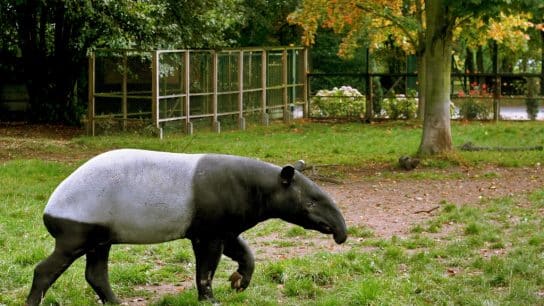The eastern gorilla is one of two species of gorilla located in equatorial Africa, geographically separated from its counterpart, the western gorilla, by approximately 900 kilometres of Congo Basin forest. Although initially classified as one species (Gorilla gorilla), the two were reclassified as distinct species in 2001 with recent studies estimating a genetic sequence divergence time of 0.9 to 1.6 million years ago (this was not a clean separation, however, as genetic exchange between the two species is estimated to have continued to a certain degree until 80,000 to 200,000 years ago). The eastern gorilla consists of two distinct subspecies, the Grauer’s gorilla (or eastern lowland gorilla) and the mountain gorilla, each accustomed to differing habitats and altitudes. Native to the Democratic Republic of Congo (DRC), Rwanda, and Uganda, a region that was the epicentre of the Great African War, eastern gorilla populations suffered extensively from civil unrest, poaching, and human population expansion. Despite the mountain gorilla showing promising signs of recovery after reaching the brink of extinction in the 1980s, Grauer’s gorillas continue to decline at a rate of 5% per year due to unabated anthropogenic pressures.
—
| Family | Hominidae |
| Genus | Gorilla |
| Species | Gorilla beringei |
| Subspecies | Grauer’s Gorilla (Gorilla beringei graueri), Mountain Gorilla (Gorilla beringei beringei) |
| IUCN Status | Critically Endangered |
| Population | Approximately 3,800 Grauer’s Gorillas, and 1,000 Mountain Gorillas |
1. Appearance
Of all four subspecies of gorilla, the Grauer’s gorilla is the largest. In fact, the subspecies constitutes the largest extant primate on Earth. It is distinguishable by its stocky body, large hands, cone-shaped skull (due to a bony crest at the top of the skull) and short muzzle, with females and non-mature males sporting darker, shorter fur than that of mountain gorillas. The subspecies also has shorter teeth and longer arms than its counterpart. Adult male Grauer’s gorillas can grow to be between 204 to 250 kilograms (250-5521 lbs) and 195 centimetres (77 in) tall, whilst females typically weigh in at approximately 100 to 125 kilograms (220-276 lbs) and reach a height 162 centimetres (64 in). Interestingly, the subspecies’ thumbs are larger than their fingers.
The mountain gorilla is the second-largest subspecies of gorilla, and has longer fur, jaws and teeth than the Grauer’s gorilla. Adult male mountain gorillas weigh in at approximately 195 kilograms (429 lbs) and reach a height of 182 centimetres, whereas females grow to be 90 to 100 kilograms with a height of 152 centimetres (60 in). Their long, thick coat provides insulation against the considerably colder temperatures they endure at higher altitudes, and adults have cone-shaped heads similar to those of the Grauer’s gorilla. The subspecies’ broad chest is typically bare, a trait that only older male Grauer’s gorillas exhibit.
Male gorillas become fully mature at the age of 12 or 13, developing a swath of silver-coloured hair down the centre of their back and thus earning themselves the nickname of “silverback” gorillas (between the ages of eight and 12, male gorillas are capable of reproduction and are known as “blackback” gorillas). Each group of gorillas is led and protected by a single dominant silverback, although the group may contain additional subordinate silverbacks as well.
Individual gorillas can be identified by unique features such as their build, manner, and nose print – a unique pattern of wrinkles on their nose. Of all four subspecies of gorilla, mountain gorillas appear to have the most distinctive nose prints.
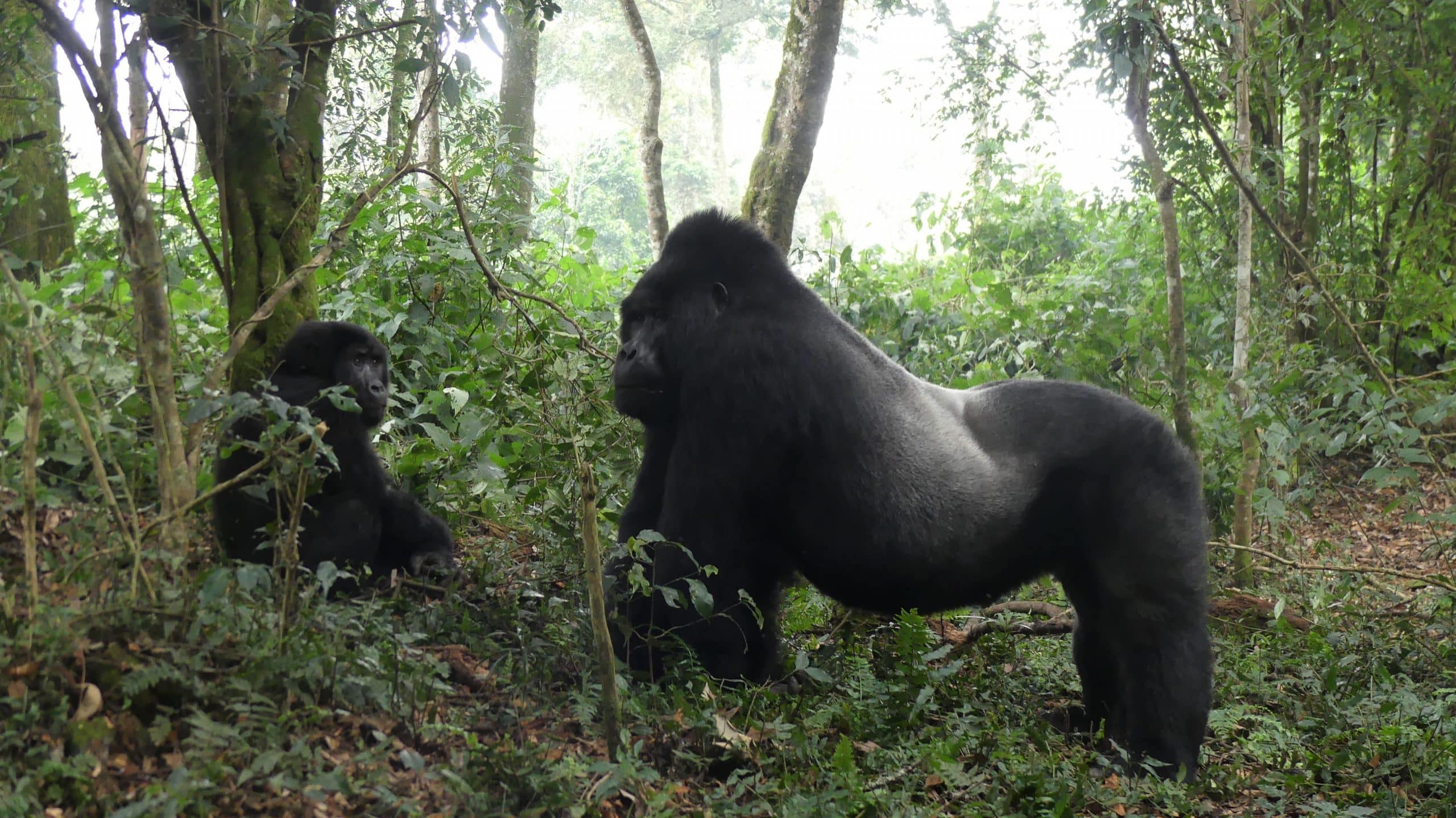
2. Diet
As the distinct subspecies of eastern gorilla are found at different elevations, food availability and dietary preferences inevitably vary between the two. Mountain gorillas are primarily herbivorous and feed on stems, pith, leaves, bark, shoots, with a preference for wild celery, thistles, nettles, wood and roots. However, they have occasionally been seen consuming larvae, snails, ants, and rotting wood, which is a good source of sodium. Whilst the subspecies consumes parts of approximately 142 different plant species, the high altitude at which the mountain gorilla forages limits their consumption of fruit to just three species.
The Grauer’s gorilla has a more diverse, seasonal diet and consumes parts of at least 104 plant species, along with nuts, seeds, fungi and herbs. Fruit consumption is highest during the wet season, between September and December, with the subspecies showing a preference for figs. Both subspecies of eastern gorilla feed almost exclusively on young bamboo shoots twice a year, when in season. Eastern gorillas consume up to 18 kilograms (40 lbs) of vegetation daily, and obtain the majority of their water intake from succulent vegetation and morning dew.

These incredible animals also use the hair on the back of their hands to absorb water to then suck and drink. Due to their sheer size, agile lips and hand dexterity, the species utilise their strength to tear apart vegetation and consume only the most palatable portions, with adult male gorillas having been observed shredding apart entire banana trees to reach the interior tender pith. The species is also believed to avoid overexploiting an area for sustenance, carefully cropping vegetation to allow for quick replenishment.
3. Habitat & Behaviour
Grauer’s gorillas are found at elevations between 600 and 2,900 metres above sea level, inhabiting dense mature and secondary lowland tropical rainforests, through transitional forests to Afromontane habitat, including bamboo forests, swamps, and peat bogs. Research suggests that the subspecies occupies a mere 13% of their former geographic range, with strongholds in the Kahuzi-Biega National Park and the Itombwe Massif.
Mountain gorillas are comprised of two subpopulations (although some primatologists believe that they constitute two distinct subspecies): one restricted to elevations above 1,400 metres (4,593 feet) in Bwindi Impenetrable National Park, Uganda; and the other located at elevations above 1,850 metres (6,070 feet) in the Virunga Mountains, a chain of volcanic mountains spanning three national parks across the Democratic Republic of Congo (DRC), Rwanda and Uganda. The Bwindi population’s habitat is characterised by steep slopes of mixed forest with dense understoreys, whilst the Virunga population’s habitat includes a variety of Afromontane vegetation types, such as bamboo forest, mixed forest, and subalpine grassland on the volcanic peaks.
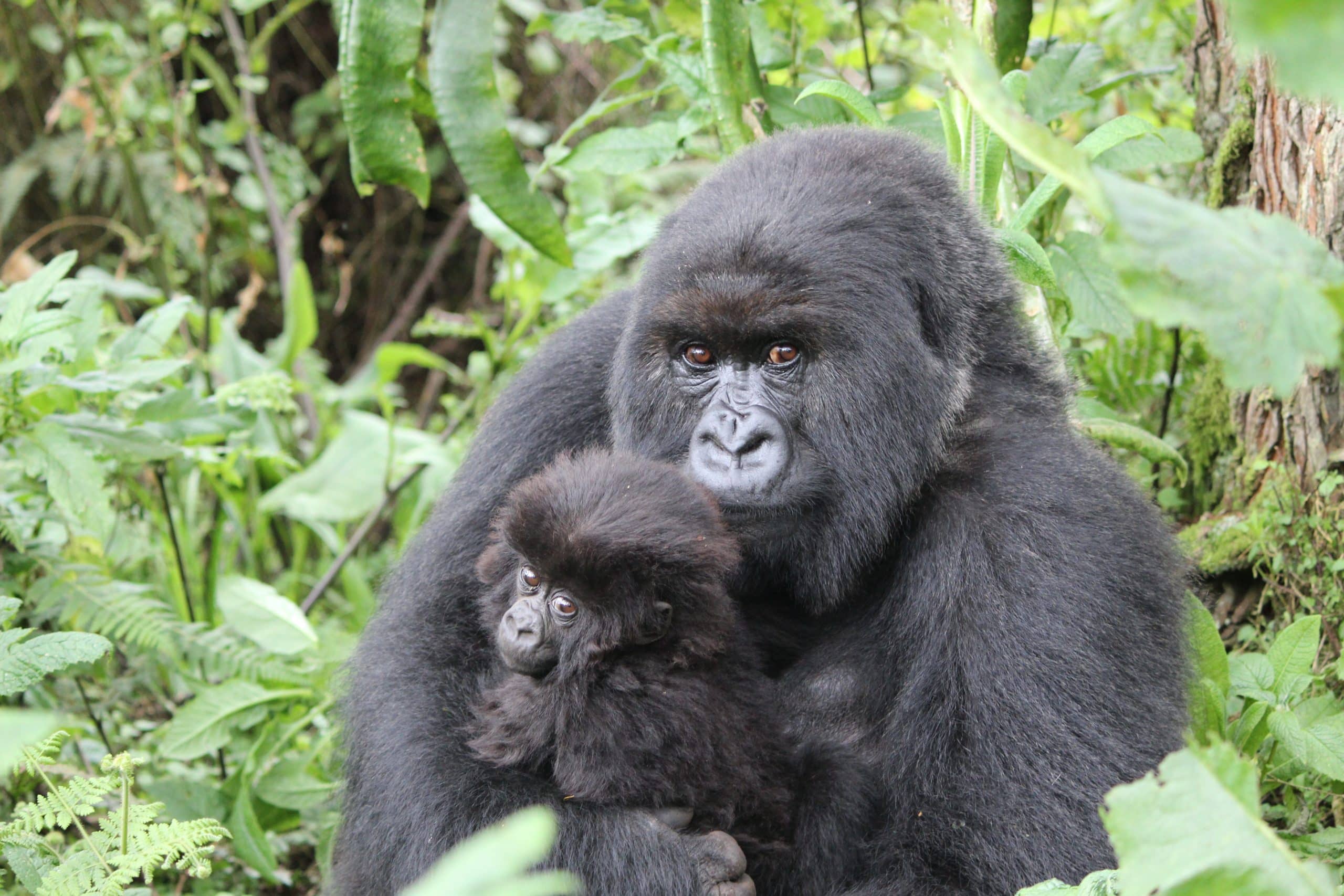
Eastern gorillas are semi-terrestrial, sometimes building their nests in trees but spending the majority of their time resting, foraging and walking on the ground. They forage and nest in a different location each day, thus preventing the overexploitation of any given area. Since the arms of eastern gorillas are longer than their legs, they utilise knuckle-walking as their preferred style of locomotion – a form of quadrupedal walking in which the gorilla curls its fingers inwards and supports its weight on its knuckles. They are capable of walking upright for short distances, although this is typically used in response to a perceived threat.
Eastern gorillas are diurnal, rising with the sun, travelling to a foraging site, feeding intensively and then indulging in rest, play and social grooming until the evening. Mountain gorilla groups sleep together on the ground in nests made from foliage, with infants sharing a nest with their mothers to stay safe and warm. Eastern gorillas have approximately 16 different types of call, including warning vocalisations and short barks when mildly alarmed or curious. The species is not known to be territorial, as there is extensive overlap between the home ranges of different groups (an area typically varying between six and 40 kilometres squared). When encountering an unfamiliar group, the dominant silverback gorilla tends to defend his troop rather than his territory. Conflicts are typically resolved through standoffs and intimidating behaviours, such as chest beating and the use of vocalisations like roars or hoots, intended to frighten off potential threats without causing physical harm since gorillas are generally calm and nonaggressive creatures.
Eastern gorillas are extremely social and live in relatively stable, polygynous or polygynandrous family groups consisting of one or more adult males, several females, their offspring, and immature relatives. Although the median group size of eastern gorillas is 10 individuals (not including infants below the age of three), groups of 30 to 40 individuals have been observed, as well as a maximum reported group size of 65. Each troop is led by a single dominant male silverback, the chief leader and protector, who selects the best locations for foraging and nesting throughout the year. Males tend to leave their biological groups at the age of 11, some travelling alone or with other males until they attract females to join their troop. Approximately 60% of females will also leave their birth group and join another troop to prevent inbreeding.
Male eastern gorillas are capable of reproducing from the age of eight to 12 years, whilst females typically begin menstruating at the age of six to seven years, followed by a period of adolescent sterility, and eventually begin reproducing at the age of ten. After a gestation period of nearly nine months a female will give birth to a single infant, with females typically giving birth every three to four years. Newborns are small and weak, weighing only two kilograms, but develop almost twice as fast as human babies. Offspring are weaned at the age of three to four years, at which point they will no longer travel on their mothers’ back. Although females are the primary caregivers of offspring, dominant silverbacks will also care for and play with infants, creating strong bonds and maintaining close relationships with them. Although the maximum life span of eastern gorillas is unknown, individuals typically live beyond 40 years.
4. Ecosystem Services
As eastern gorillas are primarily herbivorous animals, spending approximately half of their day consuming a wide variety of vegetative species, they play an essential role in maintaining the health, vitality and biodiversity of their forest habitats. These mega-grazers aid with seed dispersal and forest regeneration by travelling considerable distances to spread seeds far from the mother tree, thus keeping the diversity of vegetation in balance. Furthermore, due to their sheer size and strength, eastern gorillas create gaps in trees and shrubs as they move around and tear apart vegetation, allowing light to reach plants on the forest floor and creating paths for other species of animals to travel through.
Given their signifiant role in maintaining and protecting the integrity of their habitat, upon which a myriad of other wildlife species depend for their sustenance and survival, gorillas are considered to be an “umbrella” or “keystone” species as their conservation ultimately leads to the protection of entire ecosystems that rely on their services.
Human populations in Central Africa also rely heavily on the forests that gorillas inhabit and maintain for their food, water, medicine and livelihood. For local and indigenous populations in settlements which are in close proximity to gorilla habitat, ecotourism further provides a source of sustainable and environmentally responsible income, although this trade is not adequately regulated at the moment.
5. Threats
Classified as ‘Critically Endangered’ under the International Union for Conservation of Nature (IUCN) Red List since 2016, both subspecies of eastern gorilla have suffered extensive population declines due to political conflict, habitat loss, exposure to disease, poaching, and climate change. Only discovered in 1902, mountain gorillas were pushed to the brink of extinction in the 1980s as a result of aforementioned anthropogenic pressures. Although the subspecies is showing promising signs of recovery with gradual population increases, threats of extinction remain present throughout the mountain gorilla’s home range and thus require constant monitoring and regulation. Despite a lack of quantitative evidence demonstrating the decline in Grauer’s gorilla populations, recent surveys have estimated a reduction of 77% in one generation, from approximately 16,900 individuals in 1994 to a mere 3,800 in 2018, as well as a continued population decline rate of 5% per annum.
The main threat to mountain gorillas is habitat loss and degradation. With more than 100,000 people already residing in the remote areas surrounding primary mountain gorilla habitat, as well an annual population growth rate of 2.37% in Africa, forest habitat is increasingly cleared for human settlements, agricultural farms, and for the extraction of natural resources, such as firewood and materials used in the production of charcoal.
Between 1990 and 1994, masses of Rwandan refugees fled to camps located at the edge of the Virunga National Park, which ultimately led to unregulated firewood collection and increased instances of gorilla poaching. In 2004, approximately 15 square kilometres of prime mountain gorilla habitat was cleared in the Virunga National Park by illegal Rwandan and Congolese settlers, destroying sweeping tracts of land for agricultural and pastoral farms. European oil and gas companies have further been granted exploration concessions in the Virunga National Park, home to approximately one quarter of all mountain gorillas. Although the World Wildlife Fund (WWF) was successful in campaigning against the inclusion of primary gorilla habitat in said concessions, oil exploration is permitted in more than 85% of the national park’s area and thus poses a risk to the overall health and vitality of Virunga’s ecosystem.
Snares and traps intended for bushmeat or other wildlife species also cause injuries and fatalities to mountain gorillas, as individuals may accidentally step on a snare whilst travelling between foraging grounds. As mountain gorillas are forced further up to higher altitudes for extended periods of time, exposure to excessively cold, dangerous and sometimes fatal conditions can have devastating effects on vulnerable members of gorilla troops, such as young offspring or juveniles. Alternatively, if unable to locate palatable vegetation within the region of forestland they are restricted to, mountain gorillas may venture onto farmland in search of maize and bananas, ultimately leading to conflicts with farmers.
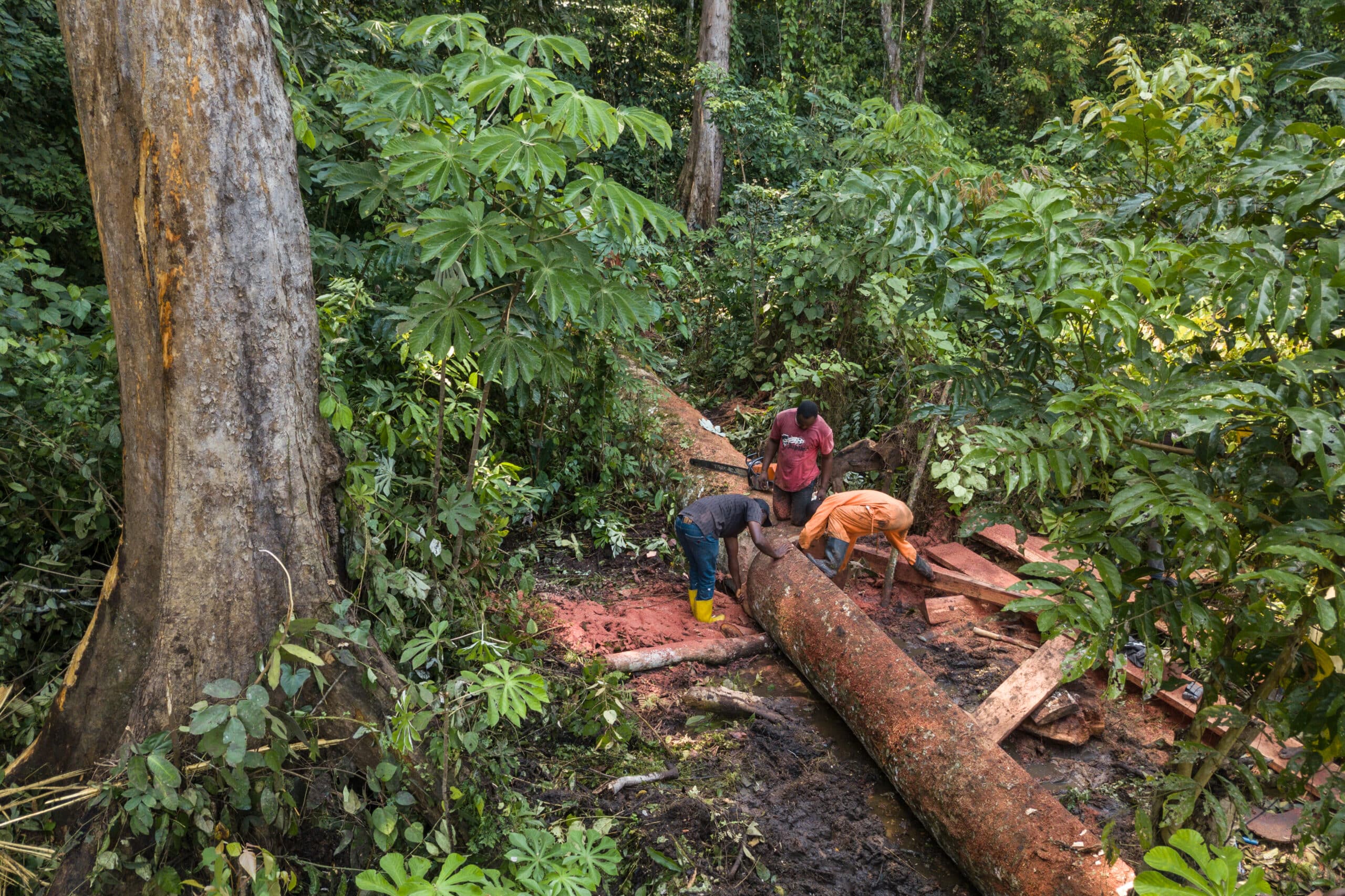
For Grauer’s gorillas, habitat destruction and fragmentation also pose a serious threat of extinction to remaining populations. As aforementioned, research suggests that the subspecies occupies a mere 13% of their former geographic range, with agricultural, pastoral and mining activities causing rampant deforestation in their endemic regions. Only a small proportion of the Grauer’s gorilla’s remaining range lies within protected areas, such as the Kahuzi-Biega National Park (a Grauer’s gorilla stronghold), and even there civil unrest and weak law enforcement have consequently led to the illegal artisanal extraction of timber and materials for charcoal production, as well as the establishment of mining operations for tin, gold, diamond, and coltan (an alloy utilised for mobile phones).
As deforestation and fragmentation force gorilla populations into isolated locations surrounded by settlements and agriculture that are extremely difficult for park guards to patrol, such as Kahuzi-Biega and in the Itombwe Massif, poachers are given easier access to gorilla troops, hunting the subspecies for bushmeat, medicine, and the illicit pet trade.
It is believed that the bushmeat trade, which occurs over a significant proportion of the Grauer’s gorilla’s range, may be a greater threat to the subspecies than habitat loss, yet the number of gorillas poached annually is not known. As illegal mining, timber and charcoal operations have expanded across the Kahuzi-Biega National Park, where civil unrest continues to demand the presence of armed groups, an influx of migrants to a region suffering from a general scarcity of affordable domestic protein has resulted in an increase in bushmeat hunting. Despite the fact that the killing, capture and consumption of great apes is illegal within Africa, miners have reportedly admitted to poaching gorillas, stating that the animals are easy to hunt with guns and provide large quantities of meat. Due to weaknesses in law enforcement capacity and the aforementioned civil unrest in the region, park rangers are often unable to monitor gorilla populations effectively and therefore poachers, traders and consumers are rarely apprehended.
Aside from the bushmeat trade, the illegal capture of live infant gorillas is also a threat to the Grauer’s subspecies, despite the apparent absence of an international market for the animals. Orphan gorillas are usually seized by wildlife authorities or perish soon after being captured. In some regions within Africa, gorilla body parts are also used in medicine and as magical charms.
As mentioned, central Africa has been destabilised by civil unrest and political conflict for over two decades, with refugees, internally-displaced citizens and armed groups putting an unsustainable amount of pressure on forestland throughout the Democratic Republic of Congo and Rwanda. Unregulated, rampant deforestation for the establishment of agricultural and pastoral farms, the rebel occupation of national parks, and the illegal circulation of military weapons and ammunition has facilitated gorilla poaching in areas affected by food scarcity and has further increased instances of human-gorilla conflicts and disease exposure. During the 1990s and the early 2000s, Virunga National Park was flooded with Rwandan refugees who depended on forest resources and bushmeat for their survival. As armed groups of rebels continue to occupy sections of the national park, monitoring and conservation work are almost impossible in the region as 140 Virunga park rangers have been killed in the line of duty since 1996. Similarly, the illegal establishment of mines and timber operations in Kahuzi-Biega National Park have hampered conservation efforts for Grauer’s gorillas, as well as preventing the establishment of eco-tourism initiatives which would greatly benefit local populations and Congolese ecosystems alike in promoting the protection and conservation of wildlife in the region.
As a result of growing instances of contact between humans and eastern gorillas, with hunters, locals and tourists entering primary gorilla habitat with increasing frequency, the species are exposed to human illnesses that could have detrimental impacts on the vitality of remaining populations. Since gorillas and humans share 98% of their DNA, a wide range of diseases carried by humans can be transmitted to gorillas, such as respiratory viruses (tuberculosis and pneumonia), scabies, the human herpes simplex virus, and the Ebola virus. However, as gorillas have not yet developed the necessary immunities to combat these illnesses, even the common cold could have devastating effects on an infected troop. In 2003, scientists estimated that around one third of the wild gorilla population had perished as a result of the Ebola virus.
Due to the fact that certain groups of gorillas are visited by researchers and tourists on a daily basis, they have become habituated to human interaction and are thus awarded better protection and regular veterinary intervention to treat contracted diseases or injuries from snares. However, unhabituated gorilla groups are almost impossible to treat.
Lastly, climate change poses a growing threat of extinction to eastern gorilla populations, especially given the fact that the species’ range is increasingly restricted by human encroachment. Rising temperatures and unpredictable rainfall patterns will have a devastating impact on food availability and habitat quality, as both subspecies depend entirely on significant quantities of palatable vegetation for their survival. Such varying climate conditions will also negatively affect agriculture in the region, leading to local populations developing an increasing reliance on forest resources and bushmeat for their sustenance, which will inevitably hamper future conservation efforts. Mountain gorillas forced into upwards migrations by deforestation and habitat loss will also face increasingly harsh conditions in unfamiliar habitats with novel or unsuitable food sources.
Similarly to humans, gorillas reproduce slowly, giving birth to a single baby at a time and raising the infant for several years before reproducing again. This low reproductive rate means that even low levels of poaching, habitat loss, disease and human conflict can have devastating effects on remaining populations, with declines in numbers talking several generations to be reversed.
You might also like: 10 of the World’s Most Endangered Animals in 2023
6. Conservation of Grauer’s Gorillas
The eastern gorilla is listed under Appendix I of the Convention on International Trade in Endangered Species of Wild Fauna and Flora (CITES), as well as under Class A of the African Convention on the Conservation of Nature and Natural Resources. Whilst the mountain gorilla has shown promising population increases over the past decade, particularly due to conservation efforts in the Virunga Massif region, Grauer’s gorilla population trends continue to decline. Nevertheless, concentrated protection and monitoring initiatives, as well as expanding community outreach and education programmes, are beginning to paint an optimistic picture for the species and its endemic habitats across the Democratic Republic of Congo (DRC), Rwanda and Uganda.
One of the foundations of gorilla conservation is scientific research and monitoring. Organisations such as the Dian Fossey Gorilla Fund have been conducting cutting-edge research on mountain gorillas since 1967, with the establishment of the Karisoke Research Center in Rwanda’s Volcanoes National Park. By collecting critical ecological information on the species, such as their behavioural traits, diet, habitat needs, range patterns, group composition, and general health, scientists and local governments are able to design effective conservation and management strategies that adequately reflect the biological needs of eastern gorillas. This is particularly true of Grauer’s gorillas since the subspecies has not been as well studied as mountain gorillas, and thus knowledge on their behaviour, habitat requirements and ecological relationships is currently lacking.
In 2012, the Fossey Fund established a research and conservation field station in Nkuba village to survey Grauer’s gorillas in the region and assess the vitality of the subspecies, as well as a number of other critical species that inhabit the forests in the area. Now known as the Nkuba Conservation Area, covering an area of more than 2,400 square kilometres, the Fossey Fund works with several local families (with the former having provided jobs and training initiatives for the latter) to protect and monitor the resident Grauer’s gorillas, tracking groups at a one-day distance since they are not habituated to human contact. The Fossey Fund further conducts research and monitoring on other endemic species of plants and animals that share habitats with eastern gorillas, tracking changes in plant availability in response to climate change and anthropogenic pressures which could potentially have critical consequences for animals across Rwanda and the Congo.
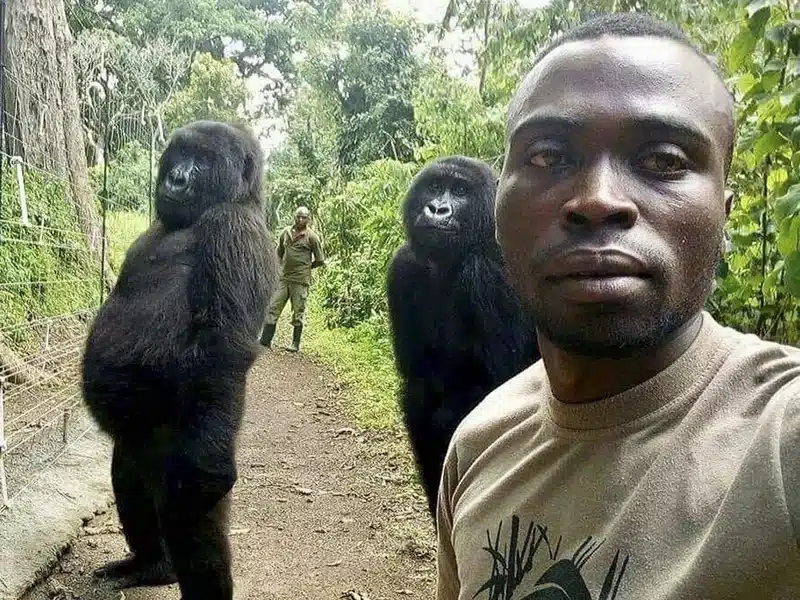
Mountain gorilla monitoring and censuses are also undertaken by the International Gorilla Conservation Programme (IGCP) – a unique coalition formed in 1991 between the World Wildlife Fund (WWF), Conservation International (CI), and Fauna & Flora International (FFI). By joining forces with local government partners from each of the three range states where eastern gorillas are currently found – the Congolese Institute for Nature Conservation (ICCN), the Rwanda Development Board (RDB), and the Uganda Wildlife Authority (UWA) – the IGCP has assisted in training community park rangers to monitor the size and health of mountain gorilla groups in Virunga National Park and Bwindi Impenetrable National Park, and has further partnered with academic research institutions to carry out conservation science studies in these regions. These efforts are aimed at helping to ensure that advocacy positions and policy decisions are based on quality scientific data.
In addition to collecting valuable scientific research, monitoring gorilla groups and their endemic ranges is essential to prevent poaching and other illegal activities that have detrimental effects on eastern gorillas and their ecosystem, such as the setting of snares, deforestation, or the extraction of natural resources. WWF and partner groups have assisted in reestablishing control over the Kahuzi-Biega National Park, rehabilitating patrol posts, training guards in effective anti-poaching and law-enforcement techniques, and providing funding and equipment for such endeavours. Monitoring activities conducted on mountain gorillas by the Fossey Fund since 1967 have had the effect of habituating the animals to the presence of humans, which also enables patrollers to prevent fatal injuries arising from snares or allowing veterinary intervention when the group falls ill from disease. However, unhabituated groups of Grauer’s gorillas are followed with caution, as human interaction can have negative effects on the behaviour or health of the subspecies if not conducted heedfully.
Previously discussed civil unrest, political instability and economic insecurity have severely hindered efforts to effectively manage and protect national parks across the DRC, Rwanda and Uganda from deforestation, poaching, and the exploitation of natural resources. Although legal frameworks are in place for managing national parks in the country, officials have difficulties with enforcing legislation due to the presence of armed groups in eastern DRC, as well as the increasing need for agriculture and infrastructural development to support Africa’s human population growth. Furthermore, whilst the entire mountain gorilla population currently resides within protected areas that are managed through active government programmes, the ICUN reported that only one quarter of the predicted range of Grauer’s Gorillas currently falls within protected areas and national parks. That is why international organisations, such as the Fossey Fund and the IGCP, are working closely with local governments and populations to set up new protected areas based on scientific data, establish community education programmes and introduce livelihood alternatives, thus encouraging the protection of natural ecosystems and reducing the need for bushmeat hunting and illicit mining.
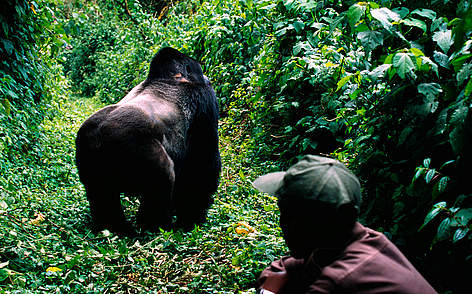
As mentioned, the Fossey Fund has helped establish the Nkuba Conservation Area, which it currently co-manages with local families who have been provided with the training and funding necessary to manage this protected area, as well as the Grauer’s gorilla population residing within its boundaries. WWF is further working to develop a management plan and consequently create a protected area for Grauer’s gorillas in the Itombwe Massif, which, together with expanding the western remit of the Kahuzi-Biega National Park, could secure approximately 50% of the subspecies’ range. WWF also works with local governments, timber companies and international lending institutions to promote sustainable, positive environmental practices in the logging industry throughout the Congo Basin, as well as to introduce reforestation programmes in affected regions. In 2018, the African Wildlife Fund (AWF) purchased land directly adjacent to Volcanoes National Park and subsequently donated it to the Rwandan government specifically for the expansion of great ape habitat. By expanding and clearly delineating the boundaries of national parks and protected areas, based on data gathered on range patterns and habitat preferences of eastern gorillas, monitoring and patrol activities are facilitated and ultimately rendered more effective in the prevention of illegal activities that hinder conservation efforts. Furthermore, by training and hiring locals to serve as patrollers and park rangers within these protected areas, populations that previously derived their income from hunting wildlife and the illicitly exploiting forest resources are provided with an alternative, sustainable source of livelihood that encourages the protection of natural ecosystems and eliminates their reliance on poaching.
On agricultural lands, WWF is helping farmers grow tea on the boundaries that their plantations share with mountain gorilla habitat, since the subspecies do not consider tea to be palatable vegetation. This prevents mountain gorillas from venturing onto cropland and potentially facing conflicts with farmers. The organisation further supports the Human Gorilla Conflict Resolution Programme (HuGo), a group of community volunteers who can be called by locals to redirect gorillas or any wildlife back into their forest habitat.
In 2009, WWF further partnered with Congolese musician Samba Mapangala and his Orchestra Virunga to record and broadcast a song titled “Les Gorilles des Montagnes”, which emphasised why mountain gorillas and their habitat in Virunga are important as the foundation of ecotourism, and further paid tribute to the rangers and conservationists who dedicate their lives to the protection of gorillas.
NGOs such as AWF and WWF also work with local communities in establishing eco-tourism initiatives to provide alternative, sustainable sources of income and to regulate the industry, which could potentially expose gorillas to disease or behavioural changes if left without governance. WWF champions Gorilla Friendly™ tourism, which are a set of standards designed to ensure a rewarding experience for tourists whilst protecting mountain gorillas from disruption. The organisation has further helped to introduce revenue sharing schemes and increased employment opportunities in the eco-tourism industry to ensure that locals benefit directly from their active efforts to protect and safeguard their environment. Profits from eco-tourism are further funnelled back into local communities through a range of enterprises and community projects to reduce the pressures of poverty and help create financial incentives for conservation efforts.
NGO Spotlight: The Dian Fossey Gorilla Fund
In September 1969, Dr. Dian Fossey, widely considered to be one of the most legendary scientists of our time, established two small tents in the Virunga wilderness – the foundations for the Karisoke Research Centre. Now conducting one of the longest-running, most comprehensive studies of any animal species anywhere in the world, the Fossey Fund carries out cutting-edge research and produces the majority of our knowledge on eastern gorillas from their extensive research programmes now housed at the Ellen DeGeneres Campus in Rwanda. Dedicated to the conservation, protection and scientific study of eastern gorillas and their surrounding ecosystems, the Fossey Fund has worked extensively with local governments and communities, as well as international partners, to implement effective, long-term conservation strategies in the eastern gorilla’s endemic range states.
The Dian Fossey Gorilla Fund focuses on four main pillars of conservation: scientific research; gorilla protection; training conservationists; and helping communities. As mentioned, the organisation conducts comprehensive monitoring and research activities, employing and training locals to serve as patrollers and park managers, and to carry out critical data collection projects in an effort to support conservation strategies and initiatives with solid scientific research on the ecological and biological needs of gorillas. In addition, park rangers remove snares and traps from the forest floor, protecting gorillas from potentially serious or fatal injuries, and deter poachers from hunting, loggers from conducting illegal deforestation, and locals from exploiting forest resources in protected areas.
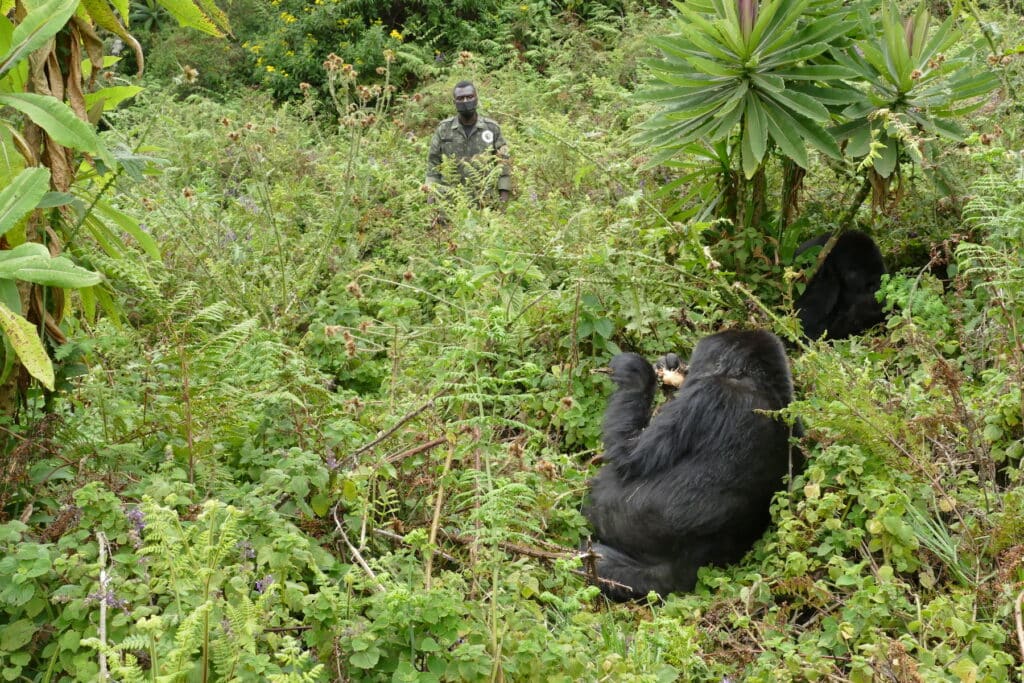
The Fossey Fund also endeavours to train young aspiring scientists and build the next generation of conservationists and educators. They do so by training local university students, providing scholarships for staff to obtain access to tertiary education, offering professional internships, building the capacity of national park staff, supporting the personal research projects of staff, and further providing them with the opportunity to experience work across different field sites and attend conservation conferences. Over 400 university students in Rwanda and Congo are invited each year to learn about conservation strategies, gorilla biology and behaviour, field research skills, scientific methods, and more, whilst students conducting their senior thesis research are intensively supervised and offered post-graduate internship opportunities. Follow-up surveys have revealed that 85% of students who complete their senior thesis work at Karisoke go into scientific or conservation related careers, with many working for the Rwandan government or local conservation organisations.
The Fossey Fund believes in sustainable, long-term conservation through the involvement and engagement of local communities, with the tag line “Helping people. Saving gorillas”. By understanding the critical needs of local populations where the Fund works, such as clean water, food security, and livelihood opportunities, the community programmes they employ address these issues and supplement them with education and outreach programmes for children and adults alike. The Fossey Fund works with local primary schools, reaching over 8,000 students, by providing supplies and learning materials for the children, as well as training courses for teachers that enable them to provide effective conservation education. The Fossey Fund also works with secondary schools across Rwanda, offering environmental clubs, class work, lectures on scientific research, the establishment of school gardens, and the opportunity to complete field research on a range of different conservation research topics. The Fund further plans special activities for World Gorilla Day each year, raising awareness on the importance of conservation through extensive community engagement.
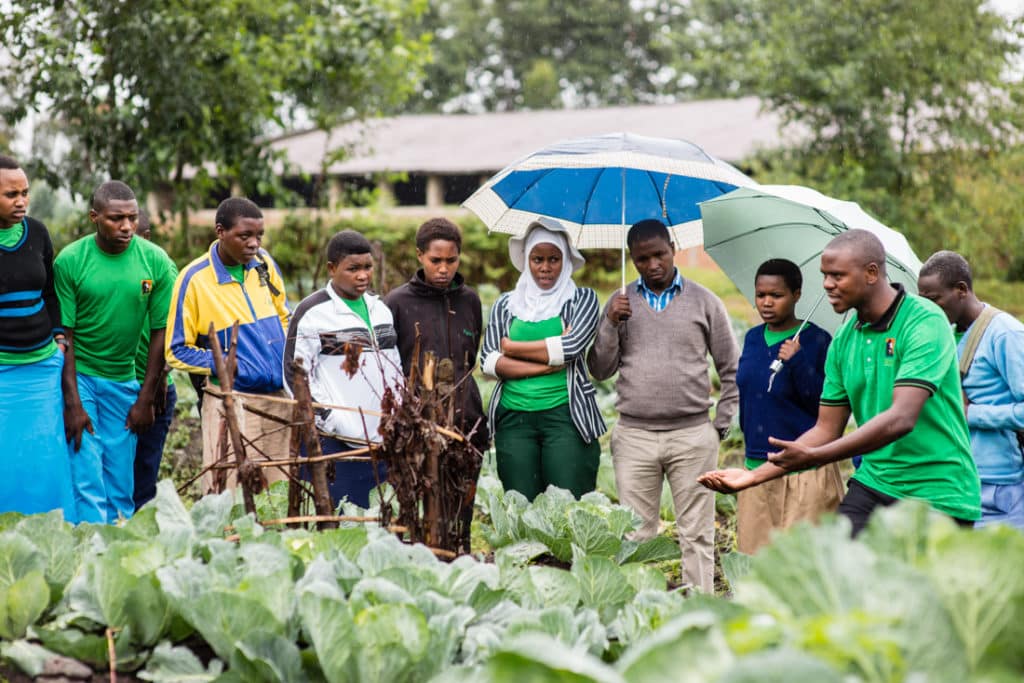
To address the poverty and livelihood challenges that many local communities face, the Fossey Fund has established programmes that aim to meet the basic needs of such populations in order to help raise their standard of living, and consequently reduce their dependance on gorilla habitat for firewood, hunting, water or crop land. Projects endeavour to increase food alternatives by helping with the planting and growth of new crops with high nutritional value, planting fruit trees, creating tree nurseries, introduce bee-keeping, and teach skills like bread-making, sewing, and mushroom-growing. The Fossey Fund further helps communities with general educational needs, in particular providing women with access to literacy programmes since formal schooling had not been an option in the past.
What You Can Do to Protect the Eastern Gorilla
- Support a gorilla NGO. There are numerous international and local organisations that are working tirelessly to protect eastern gorillas, such as the Dian Fossey Gorilla Fund. You can help support their scientific research, monitoring, and community outreach programmes by donating funds, organising a fundraiser, and spreading awareness within your local community of their work.
- Recycle your cell phones and electronics. The metals used to produce cell phones and most electronic products are mined in gorilla habitats in the Democratic Republic of Congo. By recycling your electronics, you can reduce the demand for these metals and thus help stop the establishment of illegal mines (and the gorilla poaching that often occurs at the same time).
- Purchase sustainable wood. By opting for FSC-certified forest products, you can help protect Eastern gorilla habitat by encouraging sustainably forestry and limiting illegal logging.
If you enjoyed this article about the endangered Eastern gorilla, you might also like: Red Pandas: Endangered Animals Spotlight






